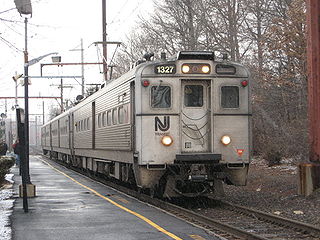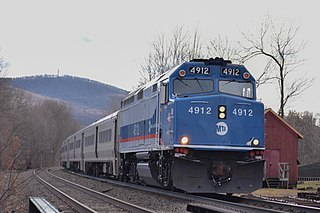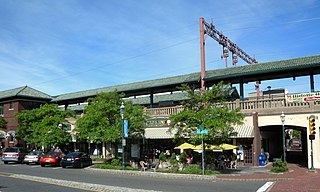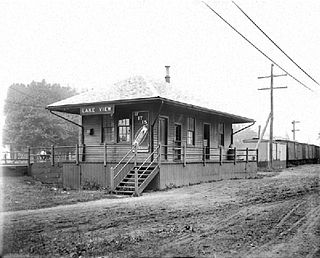Related Research Articles

The Delaware, Lackawanna and Western Railroad, also known as the DL&W or Lackawanna Railroad, was a U.S. Class 1 railroad that connected Buffalo, New York, and Hoboken, New Jersey, and by ferry with New York City, a distance of 395 miles (636 km). Incorporated in Pennsylvania in 1853 primarily for the purpose of providing a connection between the anthracite coal fields of Pennsylvania's Coal Region and the large markets for coal in New York City. The railroad gradually expanded both East and West, eventually linking Buffalo with New York City.

The Gladstone Branch is a commuter rail line operated by NJ Transit from Gladstone station, in the U.S. state of New Jersey, to either Hoboken Terminal or New York Penn Station. It is one of two branches of the Morris & Essex Lines.

The Morristown Line is an NJ Transit commuter rail line connecting Morris and Essex counties to New York City, via either New York Penn Station or Hoboken Terminal. Out of 60 inbound and 58 outbound daily weekday trains, 28 inbound and 26 outbound Midtown Direct trains use the Kearny Connection to Penn Station; the rest go to Hoboken. Passengers can transfer at Newark Broad Street or Summit to reach the other destination. On rail system maps the line is colored dark green, and its symbol is a drum, a reference to Morristown's history during the American Revolution.

The Northern Branch is a railroad line that runs from Jersey City to Northvale in northeastern New Jersey, and formerly extended further into New York State. The line was constructed in 1859 by the Northern Railroad of New Jersey to connect the New York and Erie Railroad's Piermont Branch terminus in Piermont, New York, directly to Erie's primary terminal in Jersey City, initially Exchange Place, later Pavonia Terminal. In 1870 the line was extended to Nyack, New York, and continued to provide passenger service until 1966. After the Erie's unsuccessful merger with the Lackawanna Railroad to form the Erie-Lackawanna, ownership of the line passed into the hands of Conrail upon its formation in 1976 from a number of bankrupt railroads.

Bailey Yard is the world's largest railroad classification yard. Employees sort, service and repair locomotives and cars headed all across North America. Owned and operated by the Union Pacific Railroad (UP), Bailey Yard is located in North Platte, Nebraska. The yard is named after former Union Pacific president Edd H. Bailey.

The Port Jervis Line is a predominantly single-track commuter rail line running between Suffern and Port Jervis, in the U.S. state of New York. At Suffern, the line continues south into New Jersey on NJ Transit's Main Line. The line is operated by NJ Transit Rail Operations under a contract with Metro-North Railroad (MNRR).
The Federal Express was an overnight named passenger train run by the Pennsylvania Railroad and the New York, New Haven and Hartford Railroad between Washington, DC's Union Station and Boston, Massachusetts's South Station from 1912 to 1971. At different times, its route has taken it across the Hudson River via a car float between Port Morris and Jersey City, the Poughkeepsie Bridge, and finally the Pennsylvania Tunnel and Terminal Railroad. The final routing was identical to today's high-speed Northeast Corridor.

The Lackawanna Cut-Off was a rail line built by the Delaware, Lackawanna and Western Railroad (DL&W). Constructed from 1908 to 1911, the line was part of a 396-mile (637 km) main line between Hoboken, New Jersey, and Buffalo, New York. It ran west for 28.45 miles (45.79 km) from Port Morris Junction in Port Morris, New Jersey, near the south end of Lake Hopatcong about 45 miles (72 km) west-northwest of New York City, to Slateford Junction in Slateford, Pennsylvania near the Delaware Water Gap.

Pavonia Terminal was the Erie Railroad terminal on the Hudson River situated on the landfilled Harsimus Cove in Jersey City, New Jersey. The station opened in 1861 and closed in 1958 when the Erie Railroad moved its passenger services to nearby Hoboken Terminal. The New York, Susquehanna and Western Railway also ran commuter trains from the terminal and various street cars, ferries and the underground Hudson and Manhattan Railroad serviced the station. The station was abandoned in 1958 and demolished in 1961. The site was eventually redeveloped into the Newport district in the late 20th century.

South Orange is a New Jersey Transit station in South Orange, New Jersey along the Morris and Essex rail line. It is located in the business district of South Orange, near its town hall. It is one of two train stations in the township of South Orange, Mountain Station being the other near the township border. South Orange station was built by the Lackawanna Railroad in 1916.



Sloatsburg station is a commuter rail stop on the Metro-North Railroad's Port Jervis Line, located in the village of Sloatsburg, New York at the intersection of Municipal Plaza and Mills Street.

Kingsland is a railroad station on New Jersey Transit's Main Line. It is located under Ridge Road (Route 17) between New York and Valley Brook Avenues in Lyndhurst, New Jersey, and is one of two stations in Lyndhurst. The station is not staffed, and passengers use ticket vending machines (TVMs) located at street level to purchase tickets. The station is not handicapped-accessible. Originally part of the Delaware, Lackawanna and Western Railroad's Boonton Branch, the current Kingsland station was built in 1918.

Lake View is a former railroad station for the Erie Railroad in the community of Paterson, New Jersey. The station was located at the intersection of Railway Avenue and Crooks Avenue in the Lakeview district of Paterson, just north of the Clifton town line. The station consisted of two platforms, with a small shelter-sized depot on the westbound tracks and no shelter whatsoever on the eastbound side heading towards Pavonia Terminal. The station was first opened in 1883 in the Lakeview district, and remained in use for nearly eight decades. In 1952 and 1953, as a deal made for Passaic, New Jersey, stations at Clifton and Main Street-Passaic were rebuilt. However, Lake View was not, and when the Passaic Plan was enacted on April 2, 1963, the last passenger trains served Lake View served the old 1883 depot. The depot was razed in the autumn of 1967.

The Rockport train wreck occurred in Rockport in Mansfield Township, New Jersey, United States, about three miles outside of Hackettstown, on June 16, 1925. A violent storm washed debris onto a grade crossing, derailing a Lackawanna Railroad (DL&W) train. The crash killed 42 passengers and five crewmen and injured twenty-three others.

Phoebe Snow was a named passenger train which was once operated by the Delaware, Lackawanna and Western Railroad (DL&W) and, after a brief hiatus, the Erie Lackawanna Railway (EL).

Warren was a former station for the Erie Railroad on its main line and on the Mahoning Division's first subdivision between Cleveland and Pymatuning station. Along the main line, the next station west towards Dearborn Station was Leavittsburg, while east towards Pavonia Terminal was Niles. The station was located 585.7 miles (942.6 km) from Pavonia Terminal and 412.8 miles (664.3 km) from Dearborn Station.
The 1953 New York Central Railroad accident occurred on the four-track mainline 2.4 miles east of Conneaut, Ohio at 10:02 P.M. on March 27, 1953. The accident sequence began when an improperly secured load of large pipes broke loose from a gondola car on an eastbound freight train. The loose pipe, dragged by the moving train, damaged the westbound passenger track. A passing westbound freight train crew notified the first train and stopped to assess what had happened. A fast westbound passenger train could not stop and derailed from the damaged track, colliding with the westbound freight on the adjacent track. Finally, an eastbound fast passenger train struck the derailed equipment from the first two trains. There were 21 deaths and 49 people were injured. This accident holds the record for the most trains involved in a single accident.
References
- ↑ "Poughkeepsie Journal from Poughkeepsie, New York on August 11, 1958 · Page 1". Newspapers.com. Retrieved 2020-10-28.
- ↑ "Sterlington crash, August 12, 1958". The Oneonta Star. 1958-08-12. p. 1. Retrieved 2020-10-28.
- 1 2 3 Brum, Robert. "Rockland train collision: Signalman 'gave green light to death'". The Journal News (White Plains NY). Retrieved 2020-10-28.
- ↑ police report